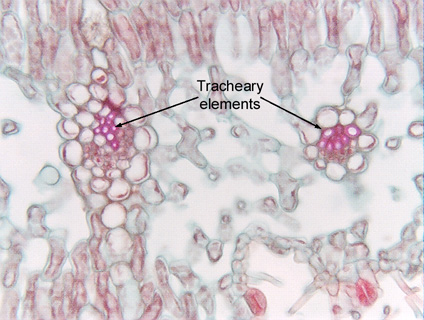 Fig.
7.1-4. Transverse section of leaf of oleander (Nerium oleander).
Unlike the large leaf veins of sugar cane (fig. 7.1-3), these are the very ends of veins in a dicot leaf.
This leaf would also have larger veins with larger tracheary elements, but as
veins extend farther into the leaf and divide into sets of ever-smaller veins,
not only do the veins become smaller, so do the tracheary elements. The arrows
indicate the tracheary elements in this oleander leaf, but they are so narrow
even at this high magnification that almost no detail at all is visible. It
would be easy to mistake these for fibers, but it would be extremely unusual for
a vein to have phloem and fibers but no tracheary elements. Such narrow, difficult-to-study tracheary elements
are common in leaves, buds, flower parts, and seeds. Many of the
slides you will study in a Plant Anatomy Laboratory have been selected to have
larger tracheary elements that have pits and perforations that are more visible.
Fig.
7.1-4. Transverse section of leaf of oleander (Nerium oleander).
Unlike the large leaf veins of sugar cane (fig. 7.1-3), these are the very ends of veins in a dicot leaf.
This leaf would also have larger veins with larger tracheary elements, but as
veins extend farther into the leaf and divide into sets of ever-smaller veins,
not only do the veins become smaller, so do the tracheary elements. The arrows
indicate the tracheary elements in this oleander leaf, but they are so narrow
even at this high magnification that almost no detail at all is visible. It
would be easy to mistake these for fibers, but it would be extremely unusual for
a vein to have phloem and fibers but no tracheary elements. Such narrow, difficult-to-study tracheary elements
are common in leaves, buds, flower parts, and seeds. Many of the
slides you will study in a Plant Anatomy Laboratory have been selected to have
larger tracheary elements that have pits and perforations that are more visible.